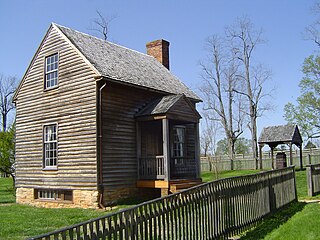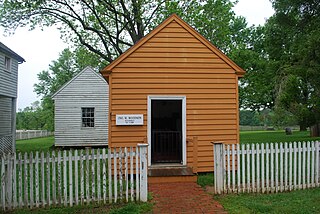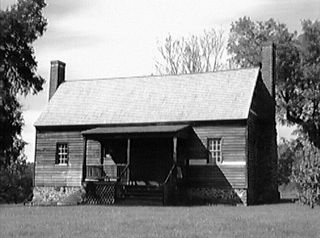
The Battle of Palmito Ranch, also known as the Battle of Palmito Hill, is considered by some criteria the final battle of the American Civil War. It was fought May 12 and 13, 1865, on the banks of the Rio Grande east of Brownsville, Texas, and a few miles from the seaport of Los Brazos de Santiago, at the southern tip of Texas. The battle took place more than a month after the surrender of the Army of Northern Virginia under Robert E. Lee to Union forces at Appomattox Court House, which had since been communicated to both commanders at Palmito. In the intervening weeks the Confederacy had collapsed entirely, so it could also be classified as a postwar action.
Gary Jennings was an American author who wrote children's and adult novels. In 1980, after the successful novel Aztec, he specialized in writing adult historical fiction novels.

The Battle of Appomattox Court House, fought in Appomattox County, Virginia, on the morning of April 9, 1865, was one of the last battles of the American Civil War (1861–1865). It was the final engagement of Confederate General in Chief Robert E. Lee and his Army of Northern Virginia before they surrendered to the Union Army of the Potomac under the Commanding General of the United States Army, Ulysses S. Grant.

Joel Walker Sweeney, also known as Joe Sweeney, was an American musician and early blackface minstrel performer. He is known for popularizing the playing of the banjo and has often been credited with advancing the physical development of the modern five-string banjo.
The Battle of Appomattox Station was fought between a Union Army cavalry division under the command of Brigadier General George Armstrong Custer and Confederate Army of Northern Virginia artillery units commanded by Brigadier General Lindsay Walker with support from some dismounted cavalrymen, artillerymen armed with muskets and some stragglers on April 8, 1865, at Appomattox Station, Virginia during the Appomattox Campaign of the American Civil War.

The Battle of High Bridge refers to two engagements fought on April 6, 1865, and April 7, 1865, near the end of the Appomattox Campaign of the American Civil War about 4 miles (6.4 km) northeast of Farmville, Virginia. The first battle is often the one identified as the Battle of High Bridge.

The 35th Virginia Cavalry Battalion, also known as White's Battalion, White's Rebels and the Comanches, was a Confederate cavalry unit during the American Civil War raised by Elijah V. White in Loudoun County, Virginia in the winter of 1861-62. The battalion was initially raised as border guards along the Potomac River below Harpers Ferry but were ultimately mustered into regular service as part of the Laurel Brigade. Despite this, they continued to play a conspicuous role in the ongoing partisan warfare in Loudoun throughout the war. The battalion was particularly notable during the 1863 Gettysburg Campaign, when it played a prominent role in the Battle of Brandy Station and subsequently conducted a series of raids on Union-held railroads and defensive positions in Maryland and Pennsylvania. The 35th was the first Confederate unit to enter Gettysburg, Pennsylvania.

Lee and Grant at Appomattox is an historical fiction children's novel by MacKinlay Kantor. It was originally published in 1950 by Random House, and later published in paperback by Sterling Point Books.

Charles Marshall was a Maryland lawyer and Confederate Army officer during the American Civil War. Marshall served as an aide de camp, assistant adjutant general and military secretary to Gen. Robert E. Lee, and later worked to establish the Lost Cause and monuments to his former comrades.

Guerrilla warfare was waged during the American Civil War (1861–1865) by both sides of the conflict, but most notoriously by the Confederacy. It gathered in intensity as the war dragged.

The Clover Hill Tavern with its guest house and slave quarters are structures within the Appomattox Court House National Historical Park. They were registered in the National Park Service's database of Official Structures on October 15, 1966.

The Charles Sweeney Cabin is a structure within the Appomattox Court House National Historical Park. It was registered in the National Park Service's database of Official Structures on June 26, 1989.

The Jones Law Office, also known as the Lorenzo D. Kelly House, is a structure within the Appomattox Court House National Historical Park. In the nineteenth century the structure was owned by Kelly and used as a single-family house. The original law office was also used as a dwelling by John Robinson for his large family in the nineteenth century after Kelly.

The Woodson Law Office is a structure within the Appomattox Court House National Historical Park. It was originally built by Samuel McDearmon in 1854 and rented by Woodson for his law office until he purchased it a couple of years later. It is a small structure and was built next to the main general store of Appomattox.

The Peers House is a structure within the Appomattox Court House National Historical Park. It was registered in the National Park Service's database of Official Structures on June 26, 1989.

The Bocock–Isbell House is a structure within the Appomattox Court House National Historical Park. It was registered in the National Park Service's database of Official Structures on June 26, 1989.

The Mariah Wright house is a structure within the Appomattox Court House National Historical Park. It was registered in the National Park Service's database of Official Structures on June 26, 1989.

The Sweeney Prizery is a structure within the Appomattox Court House National Historical Park. It was registered in the National Park Service's database of Official Structures on June 26, 1989.

The conclusion of the American Civil War commenced with the articles of surrender agreement of the Army of Northern Virginia on April 9, at Appomattox Court House, by General Robert E. Lee and concluded with the surrender of the CSS Shenandoah on November 6, 1865, bringing the hostilities of the American Civil War to a close. Legally, the war did not end until a proclamation by President Andrew Johnson on August 20, 1866, when he declared "that the said insurrection is at an end and that peace, order, tranquillity, and civil authority now exist in and throughout the whole of the United States of America."
The 5th Louisiana Infantry Regiment was a unit of volunteers recruited in Louisiana that fought in the Confederate States Army during the American Civil War. Formed in June 1861, the regiment was sent to fight in the Eastern Theater of the American Civil War. The regiment served at Yorktown, White Oak Swamp, Cedar Mountain, Second Bull Run, Harpers Ferry, Antietam, and Fredericksburg in 1862. The regiment fought at Chancellorsville, Second Winchester, and Gettysburg in 1863. At Rappahannock Station in November 1863, virtually the whole regiment was captured. The unit's remnant fought at the Wilderness, Spotsylvania, Cold Harbor, and the Valley campaigns of 1864. It served at Petersburg starting in December 1864 and a mere handful surrendered at Appomattox in April 1865.

















